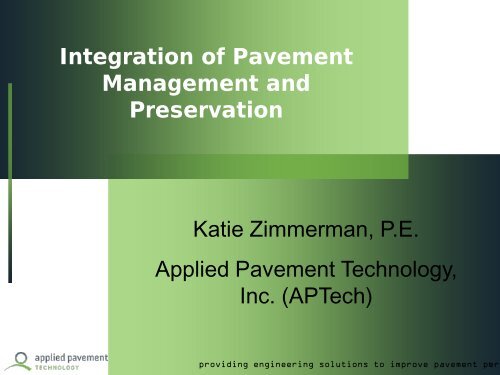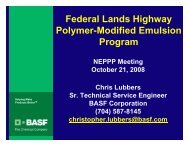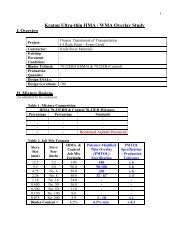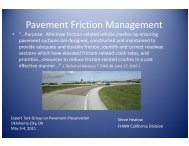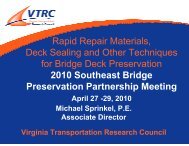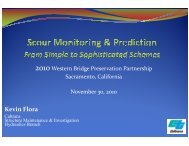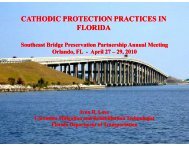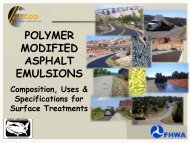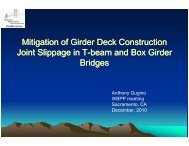Preventive Maintenance - The National Center for Pavement ...
Preventive Maintenance - The National Center for Pavement ...
Preventive Maintenance - The National Center for Pavement ...
Create successful ePaper yourself
Turn your PDF publications into a flip-book with our unique Google optimized e-Paper software.
Integration of <strong>Pavement</strong>Management andPreservationKatie Zimmerman, P.E.Applied <strong>Pavement</strong> Technology,Inc. (APTech)providing engineering solutions to improve pavement per 1
What’s Coming…providing engineering solutions to improve pavement per 3
Role of <strong>Pavement</strong> Management ina Preservation Program• Assist with project and treatment selection• Determine best project timing• Establish program funding needs• Build program support• Provide accountabilityproviding engineering solutions to improve pavement per 4
SelectionProject and Treatment Selection• Analyze pavement per<strong>for</strong>mance– Assess type of deterioration present– Assess extent of deterioration present• Identify factors that lead to the selection ofpreventive maintenance treatments– Assess what can be differentiated within thepavement management systemproviding engineering solutions to improve pavement per 5
SelectionAnalyzing <strong>Pavement</strong> Per<strong>for</strong>manceproviding engineering solutions to improve pavement per 6
Structural HMA DistressSelection•LoadRuttingPlasticDe<strong>for</strong>mationFatigueCrackingproviding engineering solutions to improve pavement per 7
SelectionFunctional Deterioration•Most pavement surface distress somehowaffects a pavement’s function by increasingroughness or reducing frictionPolishingBleeding/Flushingproviding engineering solutions to improve pavement per 8
SelectionSafety Enhancements• Restored Friction Characteristicsproviding engineering solutions to improve pavement per 9
SelectionIdentifying CandidatesWhat in<strong>for</strong>mation is needed to identifycandidates <strong>for</strong> PM?1. ______________________________2. ______________________________3. ______________________________providing engineering solutions to improve pavement per 10
SelectionTreatment Selection ApproachesEasiest Approach1. Group all preventive maintenancetreatments into one or two treatments2. Develop treatment rules, impact models,and costs <strong>for</strong> the general treatments3. Have the districts/regions select the finaltreatment based on actual conditionsproviding engineering solutions to improve pavement per 11
SelectionSample Simple Decision TreePCI100705025<strong>Preventive</strong> <strong>Maintenance</strong>Light to ModerateRehabilitationHeavyRehabilitationReconstructionAGEproviding engineering solutions to improve pavement per 12
SelectionTreatment Selection ApproachesMore Sophisticated Approach1. Develop decision trees <strong>for</strong> each preventivemaintenance treatment2. Develop per<strong>for</strong>mance models, impact rules,and costs <strong>for</strong> each treatment in the decisiontree3. Provide treatment recommendations tothe District/Regions to confirmproviding engineering solutions to improve pavement per 13
SelectionRecommendations• Use existing condition in<strong>for</strong>mation to identifycandidates <strong>for</strong> preventive maintenance• Identify the additional factors that triggerpreventive maintenance treatments• Incorporate the additional factors into yourpavement management models• Establish processes <strong>for</strong> tracking treatmentsproviding engineering solutions to improve pavement per 14
TimingProject Timing• Predict pavement deterioration• Estimate when a more substantial treatmentwill be neededWindow ofOpportunityproviding engineering solutions to improve pavement per 15
TimingMaximum Allowable DistressHMA Distress TypeExtent of ProblemMinorMajorFatigue CrackingLinear & Block Cracking“Stable” RuttingRavelingFlushing/BleedingRoughnessFriction LossMoisture DamageShovingproviding engineering solutions to improve pavement per 16
TimingSample Treatment GuidelinesHMADistressesLow Moderate HighOccasional Frequent Occasional Frequent Occasional FrequentFatigueCrackingFog Seal, DoNothingFog Seal,Chip SealChip Seal,Fog Seal,Thin HMAOverlayChip Seal,Slurry SealPatching,Chip Seal,Thin HMAOverlayRecon,PatchingEdge CrackingDo Nothing,Crack Seal orFillCrack Sealor Fill, DoNothingCrack Seal,PatchingCrackSeal,PatchingPatchingPatchingLongitudinalCrackingCrack Seal,Do NothingCrackSeal, ChipSeal, DoNothingCrack Seal,Chip SealCrackSeal, ChipSealPatching,Crack Seal,Chip SealChip Seal,Crack Seal,PatchingBleeding Do Nothing DoNothing,Chip SealChip Seal,Do Nothing,MillChip Seal,MillMill + ChipSealMill + ChipSeal, ThinHMAOverlayproviding engineering solutions to improve pavement per 17
Treatment Guidance - IDOTTiming<strong>Pavement</strong> ConditionsAlligator/ Fatigue Cracking 1Block Cracking"Stable" Rutting 2Joint Reflection and Transverse Cracking 3L1 F F NR NR NR NR F F F F F F F F F NR RL2, L3, L4 NR NR NR NR NR NR NR NR NR NR NR NR NR NR NR NR FM1 R R F R R F R R R R R R F F R F NRM2 R R NR NR F NR F NR F F F F NR NR NR NR NRM3, M4 F F NR NR NR NR NR NR NR NR F F NR NR NR NR NRN1, N2 NR NR NR NR NR NR F R F F R R R* F R* F RN3 NR NR NR NR NR NR NR F NR NR R R R* NR R* F FO1 NR NR F R R NR F R R R F F R** F NR F NRO2, O3 R R NR NR NR NR NR F F F F F F NR NR NR NRO4, O5 F F NR NR NR NR NR NR NR NR NR NR NR NR NR NR NROverlayed Patch Reflective Cracking P1, P2, P3, P4, P5 F* F* F* F* F* F* F* F* F* F* F* F* F* F* F* F* F*Q1 R R F F F NR F F F F F F F F F F NRQ2, Q3 R F NR NR F NR NR F F F F F F F F F NRQ4, Q5 NR NR NR NR NR NR NR NR NR NR F F NR NR NR NR NRR1 R R F F F NR F F F F F F F F F F NRR2, R3 F F NR NR NR NR F F F F F F F NR F NR NRR4, R5 NR NR NR NR NR NR NR NR NR NR NR NR NR NR NR NR NR<strong>Center</strong>line Deterioration S1, S2, S3, S4 F* F* F* F* F* F* F* F* F* F* F* F* F* F* F* F* F*Edge CrackingT1 F F F R R NR F F R F R R R** F F F RT2 F F NR NR NR NR NR F F F F F F NR F NR RT3, T4 NR NR NR NR NR NR NR NR NR NR NR NR NR NR NR NR FPermanent Patch Deterioration U1, U2, U3, U4 F* F* F* F* F* F* F* F* F* F* F* F* F* F* F* F* F*Shoving, Bumps, Sags, and CorrugationWeathering/ RavelingMicrosurfacingV1 NR NR NR NR NR NR NR F F F R R R F F R FV2, V3 NR NR NR NR NR NR NR NR NR NR R R R NR F R FW1, W2 NR NR F F F F R R R R F F F F F F NRW3, W4 NR NR NR NR NR NR F F F F R R R* NR NR NR NRReflective D-Cracking X1, X2, X3 NR NR NR NR NR NR NR NR NR NR F F NR F NR F NRFriction Poor NR NR NR R R NR R R R R F F R R F F NRADTSeverity Levels<strong>Pavement</strong> ConditionsLongitudinal / <strong>Center</strong> of Lane CrackingReflective Widening CrackCrackFillingCrackSealingLongitudinal / <strong>Center</strong> of Lane CrackingReflective Widening Crack< 5,000 R R R R R R R R R R R R R R R R R5,000 – 10,000 R R F F F R F R R R F R R R R R R> 10,000 R R NR NR NR NR NR F F F NR R R R R R RRelative Cost ($ to $$$$) $ $ $ $$ $$ $$ $$ $$ $$ $$ $$$ $$$ $$$ $$$ $$$$ $ VariesR - Recommended treatment <strong>for</strong> the specified pavement condition. Care must be examined in making sure that all critical distress types are addressed by the selected treatment.R* - Recommended treatment when used with milling prior to treatment.R** - Used in combination with crack sealing.F - Feasible treatment but depends upon other project constraints including other existing distresses.F* - This is a localized distress and should be treated locally while other distress types present should dictate choice of global treatment.NR - Treatment is not recommended to correct the specified pavement condition.1- Preservation treatments do not correct alligator cracking. Of the treatments, chip seals are most appropriate at addressing the alligator cracking.2 - If stable rutting is present without other distresses, microsurfacing or mill and overlay are the recommended treatments.3 - If cracking is joint reflection related, the preservation treatments will not correct the distress.FogSealSandSealScrubSealRejuvntrSlurrySealSeverity LevelsChipSealCapeSealCIR HIRRejuvntrThin HMAOverlaySlurrySealUltra- Thin BondedWearing CourseUTWColdMillMicrosurfacingDrainagePresrvtnChipSealCapeSealQ1 NR F F F FQ2, Q3 NR NR F F FQ4, Q5 NR NR NR NR NRR1 NR F F F FR2, R3 NR F F F FR4, R5 NR NR NR NR NRproviding engineering solutions to improve pavement per 18
TimingTime-Based Schedule ExampleNew York State Initial Guidelines <strong>for</strong> Treatment Application CyclesTreatment Type• PCC pavement joint and crack sealing• HMA pavement crack sealing• Thin HMA overlays (38 mm [1.5 in])• Surface treatments of HMA pavements• Surface treatments of shoulders• Clean drainageAppl.Cycle, yrs84124410providing engineering solutions to improve pavement per 19
TimingRecommendations• Use per<strong>for</strong>mance models to determine the“window of opportunity”• Establish internal guidelines on the amountof deterioration that can be addressed withpreventive maintenance treatments• Establish dedicated funding so scheduledtreatments are applied on timeproviding engineering solutions to improve pavement per 20
FundingProgram Funding100From Indiana DOT <strong>for</strong> its Interstates90Average condition8070605040302010019981999Rehabilitation/ <strong>Preventive</strong> <strong>Maintenance</strong>$100 million/ $15 million$125 million/ $12.5 million$125 million/ $25 million200020012002200320042005200620072008200920102011201220132014201520162017Year of analysisproviding engineering solutions to improve pavement per 21
FundingRecommendations• Use your pavement management analysis todetermine the appropriate funding level <strong>for</strong>your pavement preservation program• Link funding levels to per<strong>for</strong>mance targetsproviding engineering solutions to improve pavement per 22
SupportProgram Support• Promote concepts• Demonstrate cost effectiveness• Illustrate impacts with and without preventivemaintenance• Justify expendituresproviding engineering solutions to improve pavement per 23
SupportPromoting Concepts• Educating decision makersCondition Deterioration & Treatment Triggers / Resets100ConditionIndexOriginal <strong>Pavement</strong>$ 1 $ 2 $ 6 $ 15Seal CoatThin OverlayStructural Overlay50Remaining Service Life (RSL) = 0ReconstructionYears / AADT (ESALs)providing engineering solutions to improve pavement per 24
SupportGood Roads Cost Less (1977)Thickness Required <strong>for</strong> 1M Additional Load ApplicationsGood<strong>Pavement</strong> ConditionFairPoorVeryPoor1 2 3 4 5 6 7 8Thickness (in)providing engineering solutions to improve pavement per 25
SupportProgram Support0 to 25% of asset lifeMinor <strong>Maintenance</strong>Now In 12 Years In 24 Years26%23%14%25 to 50% of asset life<strong>Preventive</strong> <strong>Maintenance</strong>37%26%23%26%50 to 75% of asset lifeRehabilitation14%37%75 to 100% of lifeReplacement23%14%37%<strong>The</strong> dynamic life cycle requirements of an aginginfrastructure…Hamilton, Canadaproviding engineering solutions to improve pavement per 26
SupportChallenge• Does distress dataallow you to measurethe effectiveness of apreventivemaintenancetreatment?– Example: cracksealingproviding engineering solutions to improve pavement per 27
SupportRecommendations• Incorporate preventive maintenancetreatments into the analysis• Demonstrate benefits using strategies thatresonate with decision makers• Improve your measures of effectiveness asdata become availableproviding engineering solutions to improve pavement per 28
AccountabilityAccountabilityproviding engineering solutions to improve pavement per 29
AccountabilitySetting Per<strong>for</strong>mance TargetsPercent <strong>Pavement</strong> in Good ConditionPlot100$25M/year8060$5M/year4020Do NothingPlot end pointsversus annual budgetPlot00 1 2 3 4 5 6 7 8 9 10Time (Years)providing engineering solutions to improve pavement per 30
AccountabilitySetting Per<strong>for</strong>mance TargetsPercent <strong>Pavement</strong> in Good Condition in 10 Years100$25M/year8060$5M/year40200Do nothing0 5 10 15 20 25Relative Budget, $Millions/Yearproviding engineering solutions to improve pavement per 31
Enhance AccountabilityAccountability• <strong>Pavement</strong> Management PlansBackgroundDescription ofServices ProvidedDescription of<strong>Pavement</strong>ConditionsCommitmentto the UsersDescription ofTargeted ServiceLevelPer<strong>for</strong>manceMetricsFinancialRequirementsand FundingStrategiesProgramDescriptionsproviding engineering solutions to improve pavement per 32
Asset Plansproviding engineering solutions to improve pavement per 33
AccountabilityRecommendations• Establish the processes necessary to trackpreventive maintenance applications• Prepare <strong>Pavement</strong> Asset Plans showingwhat funding is needed and how it will beused.providing engineering solutions to improve pavement per 34
Making Improvements• Address the core questions• Identify factors impacting the degree towhich pavement preservation is integrated inyour pavement management system• Consider creating a <strong>Pavement</strong> PreservationEngineer position• Keep moving <strong>for</strong>ward!providing engineering solutions to improve pavement per 35
5 Core Questions• What is the current state of my pavements?• What is the required level of service?• Which pavements are most critical toachieving our per<strong>for</strong>mance objectives?• What are the best strategies <strong>for</strong><strong>Maintenance</strong> & Operations and CapitalImprovement investments?• What is the best long-term funding strategy?providing engineering solutions to improve pavement per 36
Moving ForwardIdentify YourNeedsDevelop A Plan ForAddressing GapsDetermineWhat’s AvailableIdentify AnyGapsproviding engineering solutions to improve pavement per 37
Addressing Data Issues• Accessibility• Integrationproviding engineering solutions to improve pavement per 38
Addressing Institutional Issues• Resistance to change• Disconnected decisionsproviding engineering solutions to improve pavement per 39
Resources Available• NHI 131116: <strong>Pavement</strong> Management:Characteristics of an Effective Program– Free to state highway agencies– 1 day– Conducted by FHWA– www.nhi.fhwa.dot.gov (In the training catalog)• Final Report from the First <strong>Pavement</strong> ManagementPeer Exchange• http://www.fhwa.dot.gov/pavement/pub_details.cfm?id=600providing engineering solutions to improve pavement per 40
Useful Resources - Websites• FHWA <strong>Pavement</strong> Preservation website:www.fhwa.dot.gov/preservation• FHWA Office of Asset Management:www.fhwa.dot.gov/infrastructure/asstmgmtproviding engineering solutions to improve pavement per 41
It’s Time• <strong>Pavement</strong> management should be designedto support an agency’s decision processes• Today, that means more than ever be<strong>for</strong>ewith the increased demands associated with:– <strong>Pavement</strong> preservation– MEPDG calibration– HPMS changes– Accountability requirementsproviding engineering solutions to improve pavement per 42
Contact info:Katie Zimmermankzimmerman@appliedpavement.com(217) 398-3977providing engineering solutions to improve pavement per 43


